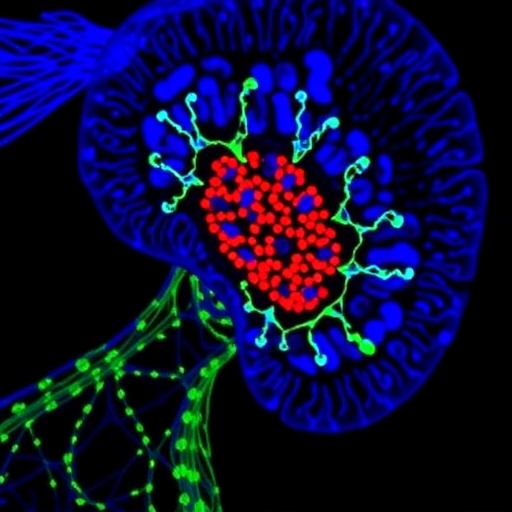In a groundbreaking advancement that could reshape the therapeutic landscape for cervical cancer patients, researchers have unveiled a pivotal molecular mechanism driving the aggressive spread of cancer cells to lymph nodes. The study, recently published in Cell Death Discovery, elucidates how CREB5, a transcription factor, orchestrates nodal metastasis in cervical cancer by modulating APLN-induced lymphangiogenesis, offering a promising avenue for targeted intervention.
Cervical cancer remains a formidable challenge globally, with nodal metastasis significantly aggravating patient prognosis and complicating treatment strategies. Understanding the molecular underpinnings of this metastasis is paramount. The research team, led by Xia, M. and colleagues, delved deeply into the cellular and molecular crosstalk underlying this process, focusing on the CREB5 protein’s role in promoting lymphatic vessel formation within tumor environments.
CREB5, known as cAMP response element-binding protein 5, functions as a transcription factor regulating gene expression in various cellular contexts. Its aberrant expression and activity have been implicated in several malignancies, yet its specific contribution to cervical cancer metastasis was hitherto unclear. Employing comprehensive molecular biology techniques, the authors demonstrated that CREB5 expression correlates strongly with enhanced metastatic potential and poor clinical outcomes in cervical cancer patients.
At the heart of this metastatic cascade lies APLN, or apelin, a peptide ligand that activates the APJ receptor, participating in multiple physiological processes including angiogenesis and lymphangiogenesis. The team’s compelling data reveal that CREB5 directly upregulates APLN expression, thereby intensifying the lymphangiogenic response within tumor microenvironments. This heightened lymphangiogenesis facilitates cancer cell dissemination to regional lymph nodes, accelerating disease progression.
Subsequent functional assays affirmed that silencing CREB5 leads to a dramatic reduction in APLN levels, concomitantly diminishing lymphatic vessel formation and hindering metastatic spread in vivo. These findings underscore CREB5’s role not only as a biomarker for aggressive cervical cancer but also as an actionable molecular target whose disruption could stymie metastasis at its origin.
The researchers meticulously mapped the signaling axis connecting CREB5 to APLN-mediated pathways, uncovering a complex regulatory network that integrates environmental cues within the tumor milieu. This mechanistic insight sheds light on how cervical cancer manipulates lymphatic architecture to foster an environment conducive to tumor cell migration, fundamentally advancing our understanding of metastatic biology.
This study also highlights the interplay between tumor cells and endothelial components, illuminating how CREB5 influences lymphatic endothelial cell behavior indirectly through APLN secretion. Such paracrine signaling is instrumental in remodeling the peritumoral lymphatic system, effectively creating highways for metastatic cells to navigate.
Importantly, the elucidation of CREB5’s role offers a dual benefit: it serves as a prognostic indicator for lymph node involvement and opens up potential therapeutic modalities centered on blocking CREB5 or inhibiting the APLN-APJ signaling axis. Pharmacological blockade of this pathway might disrupt lymphangiogenesis, curtailing nodal metastases and improving survival rates.
From a clinical perspective, integrating CREB5 expression profiling into diagnostic protocols could enhance stratification of cervical cancer patients, enabling personalized treatment regimens that account for metastatic risk. Additionally, therapeutic agents targeting this pathway could be synergistically combined with existing chemoradiation therapies to overcome resistance and reduce recurrence.
Moreover, this research aligns with the broader oncological paradigm emphasizing the tumor microenvironment’s influence on cancer progression. By pinpointing lymphangiogenesis as a CRFB5-driven event, future studies may explore similar mechanisms in other malignancies where lymphatic dissemination is prevalent, potentially broadening the impact of these findings.
The versatility of CREB5 as a molecular entity also invites exploration into its upstream regulators and downstream effectors beyond APLN, delineating a more comprehensive signaling landscape that governs metastasis. Such investigations could unravel additional targets amenable to pharmaceutical intervention, further enhancing therapeutic arsenals.
Intriguingly, the fidelity of this mechanism in patient-derived samples bolsters the translational relevance of the work, suggesting that targeting the CREB5-APLN axis is not merely a theoretical exercise but a viable strategy in clinical oncology. Ongoing clinical trials may soon incorporate these molecular insights as biomarkers for patient selection or therapeutic monitoring.
This discovery also prompts a reevaluation of lymphangiogenesis inhibitors currently in development or clinical use, potentially guiding refinement toward agents that more precisely incapacitate CREB5-mediated pathways. This precision medicine approach promises to minimize off-target effects while maximizing antimetastatic efficacy.
In summary, the innovative study by Xia, M. et al. represents a milestone in cancer biology, uncovering how CREB5 reprograms cervical cancer cells to exploit lymphangiogenesis for metastatic dissemination. The implications of this work resonate strongly within the oncological community, opening new frontiers for research, diagnosis, and treatment designed to improve patient outcomes in a malignancy that continues to exact a heavy toll worldwide.
As the field advances, further corroboration of these findings and clinical translation will be critical. However, the unveiled CREB5-APLN axis firmly establishes a mechanistic foundation upon which future therapeutics and diagnostic tools can be built, signaling hope for more effective management of cervical cancer metastasis.
Subject of Research: The molecular mechanisms underlying nodal metastasis in cervical cancer, focusing on the role of CREB5 in regulating APLN-induced lymphangiogenesis.
Article Title: CREB5 promotes nodal metastasis of cervical cancer by regulation of APLN-induced lymphangiogenesis.
Article References:
Xia, M., Yuan, L., Chen, L. et al. CREB5 promotes nodal metastasis of cervical cancer by regulation of APLN-induced lymphangiogenesis. Cell Death Discov. 11, 488 (2025). https://doi.org/10.1038/s41420-025-02782-5
Image Credits: AI Generated
DOI: https://doi.org/10.1038/s41420-025-02782-5
Tags: APLN-induced lymphangiogenesiscancer cell spread to lymph nodescancer research breakthroughs 2023cervical cancer prognosis factorsCREB5 and APLN interactionCREB5 in cervical cancerlymphatic vessel formation in tumorsmolecular biology of metastasisnodal metastasis mechanismstargeted therapy for cervical cancertherapeutic interventions for cervical cancertranscription factors in cancer progression





